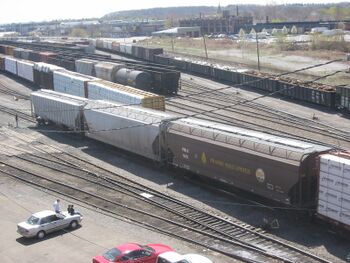Railyard: Difference between revisions
Jump to navigation
Jump to search

imported>Caesar Schinas m (Update image code) |
imported>John Stephenson (link) |
||
| Line 2: | Line 2: | ||
{{Image|Hopper cars in a railyard.jpg|right|350px| A small railyard displaying a variety of different kinds of freight car.}} | {{Image|Hopper cars in a railyard.jpg|right|350px| A small railyard displaying a variety of different kinds of freight car.}} | ||
A '''railyard''' is a facility for assembling and marshaling [[railway vehicles]] into [[ | A '''railyard''' is a facility for assembling and marshaling [[railway vehicles]] into [[train (transport)|trains]]. | ||
Railyards consist of parallel tracks, connected by [[railway switch|switches]]. The vehicles in a [[freight train]] might have to be in a particular order. Before it leaves yard locomotives would move individual fragments back and forth onto the secondary lines, adding and subtracting vehicles, until the vehicles could be marshaled into the right order. | Railyards consist of parallel tracks, connected by [[railway switch|switches]]. The vehicles in a [[freight train]] might have to be in a particular order. Before it leaves yard locomotives would move individual fragments back and forth onto the secondary lines, adding and subtracting vehicles, until the vehicles could be marshaled into the right order. | ||
Latest revision as of 02:27, 19 March 2010
A railyard is a facility for assembling and marshaling railway vehicles into trains.
Railyards consist of parallel tracks, connected by switches. The vehicles in a freight train might have to be in a particular order. Before it leaves yard locomotives would move individual fragments back and forth onto the secondary lines, adding and subtracting vehicles, until the vehicles could be marshaled into the right order.
